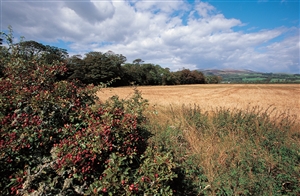Winter is a tough time for wildlife, but especially so for those species which call farmland home. Many farmland bird species such as grey partridge, yellowhammer and corn bunting depend on seeds to survive. Other species such as thrushes and bullfinches depend on berries, fruit and grubs found along our hedgerows.

Hawthorn hedgerow with berries. Copyright: RSPB Images, Andy Hay
In arable areas the widespread change…